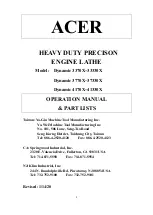
The unpainted surfaces are coated with a heavy-
duty rust preventative that prevents corrosion
during shipment and storage.
This rust preventative has been a close ally
and guardian since this item left the factory.
If the unpainted surfaces are free of rust, then
be thankful that the rust preventative did its
job...and try to stay thankful as you clean it off,
because it can be challenging to remove if you are
unprepared and impatient.
Plan on spending time cleaning and removing
the rust preventative. The time you spend doing
this will reward you with smooth sliding parts
and a better appreciation for the proper care of
the unpainted surfaces.
Although there are many ways to successfully
remove the rust preventative, these instructions
walk you through what works well for us.
Before cleaning, gather the following:
• Disposable Rags
• Cleaner/degreaser
• Safety glasses & disposable gloves
Note:
Automotive degreasers, mineral spirits
or WD•40 can be used to remove rust
preventative. Before using these products,
though, test them on an unnoticeable area
of a painted area to make sure they will not
damage it.
Basic steps for removing rust preventative:
1. Put on safety glasses and disposable gloves.
2. Coat all surfaces that have rust preventative
with a liberal amount of your cleaner or
degreaser and let them soak for few minutes.
3. Wipe off the surfaces. If your cleaner or
degreaser is effective, the rust preventative
will wipe off easily.
Note:
To clean off thick coats of rust preventative
on flat surfaces, such as beds or tables, use
a PLASTIC paint scraper to scrape off the
majority of the coating before wiping it off
with your rag. (Do not use a metal scraper or
it may cause scratches.)
4. Repeat Steps 2–3 as necessary until clean,
then coat all unpainted surfaces with a
quality metal protectant to prevent rust.
GAS
Gasoline and petroleum
products have low flash
points and can explode
or cause fire if used for
cleaning. Avoid using these
products to remove rest
preventative.
Many cleaning solvents are
toxic if inhaled. Minimize
your risk by only using
these products in a well
ventilated area.
Avoid chlorine-based solvents, such as
acetone or brake parts cleaner that may
damage painted surfaces. Always follow the
manufacturer’s instructions when using any
type of cleaning product.
Cleaning & Protecting
-4-
For Product Mfg. Since 1/10
Model SB1269
P R E P A R A T I O N




























